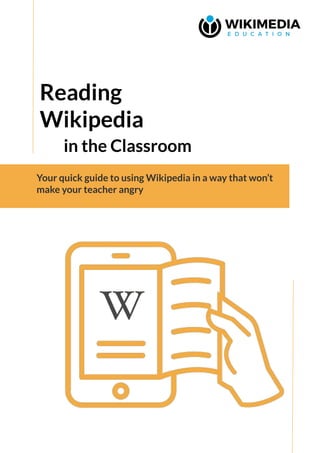
Reading Wikipedia in the classroom (student edition)
- 1. Your quick guide to using Wikipedia in a way that won’t make your teacher angry Reading Wikipedia in the Classroom
- 2. How reliable is it? Research(1) carried out in 2005 revealed that Wikipedia is as accurate as the Encyclopedia Britannica. While not all articles in Wikipedia have the same quality, the best way to make the most out of this resource is to understand its behind-the-scenes community and practices, and how to assess the information it contains. Who writes Wikipedia? Volunteers from all parts of the world and different fields of expertise contribute their knowledge to build Wikipedia. For example, volunteers from Bolivia work collaboratively to create content and upload multimedia resources about their own history, cultural traditions, and monuments for the world to see. Part of this community also carries out offline and online activities that train people and institutions to contribute to Wikipedia. What is Wikipedia? Wikipedia is the free online encyclopedia that anyone can edit. It is available in 300 languages and it is part of a larger group of free knowledge projects supported by the Wikimedia Foundation. Like other encyclopedias, Wikipedia should be used as a starting point in our quest for knowledge. It should not be used as the only source, or as a reference in an essay. How can Wikipedia help you in the classroom? Students around the world are using Wikipedia to develop 21st century skills. From improving articles about local landmarks to creating biographies of notable professionals, students are editing Wikipedia to enhance their learning experience while contributing to free knowledge. Wikipedia can be a powerful tool for helping students understand how knowledge is constructed, the knowledge gaps found in digital content, and how to critically evaluate the information they find online. Sometimes, when we use Wikipedia for our homework or to learn more about a subject, our teachers get upset. This might be because they don’t trust Wikipedia, or maybe we used it in the wrong way (copy/pasting!). This guide will help you use Wikipedia to grow as a learner. It will give you the tools you need to use Wikipedia to get information without upsetting your teachers! Let’s start with some basic concepts: Welcome!
- 3. Anatomy of a Wikipedia article The numbers found along a Wikipedia article indicate the sources used to create it. Articles can be assessed according to the number and quality of sources they have. There are badges that highlight articles as “good” or “featured” content. Similarly, warning banners indicate areas of improvement for an article, citations needed, or potential conflicts. This tab shows the edits done on a Wikipedia article, how the article has evolved over time, and how up-to-date the information is. The “Talk” section shows discussions around the topic of the article. It shows how knowledge is constructed through informed exchanges. The lead section summarizes the article’s key points. It provides you with an overview of the topic. But wait! That’s not all! Use the search box to look for more information without leaving Wikipedia Blue links allow you to explore more Wikipedia articles related to the topic. Red links indicate that the page does not exist yet but it probably should! Let's explore the different elements that are generally part of a Wikipedia article. They can provide you with a more critical approach to the information you consume online and offline.
- 4. Anatomy of a Wikipedia article A table of contents presents how the content of an article is organized. It allows you to understand how the article is structured and helps you to optimize your information search. This section compiles all the sources cited in an article. It can also contain notes clarifying or expanding on information contained in the article. You can use this section to expand your search for information beyond Wikipedia and find academic sources that you can include in their own research. Wikipedia should only be the beginning of your journey. As you keep exploring a Wikipedia article you will find more elements that can help you to structure your search for information and to expand your sources.
- 5. Try it yourself! Visit the Wikipedia articles below and make an initial assessment of their quality based on the positive and negative indicators presented: ● BTS ● Greta Thunberg ● World Organization of the Scout Movement Positive indicators: ★ It contains several references from reliable sources. ★ It has an informative and clear lead section. ★ It covers different relevant aspects of one topic. ★ It presents balanced and organized content. ★ It is written from a neutral point of view. Negative indicators: ❖ It does not have any references. ❖ It has a warning banner. ❖ It contains spelling or grammatical errors. ❖ It contains outdated information about a current topic. ❖ It contains unsourced opinions and value statements. Luckily, all of these can be improved! Indicators of quality on a Wikipedia article
- 6. My Knowledge Quest Instructions: Use this worksheet to document your search for information on Wikipedia. Answer each question in the corresponding box to reach the “Finish” line. Compare your findings with your classmates!
- 7. ● “My Knowledge Quest” editable version: Available on Wikimedia Commons (https://w.wiki/WMB) ● Other activity suggestions: #EduWiki challenges (https://tinyurl.com/y9bxvdww) ● Motivational video: Knowledge belongs to all of us (https://w.wiki/WLP) ● John Green’s guide to using Wikipedia: Crash Course Navigating Digital Information (https://youtu.be/ih4dY9i9JKE) ● Wikimedia education stories: This Month in Education (https://w.wiki/Dfq) ● Find Wikipedians in your country: Wikimedia movement affiliates (https://w.wiki/WLR) This open educational resource is registered under a CC BY-SA 4.0 license. You are free to download, share, reuse, remix, and adapt it. Additional resources: References: 1. Giles, J. Internet encyclopaedias go head to head. Nature 438, 900–901 (2005). https://doi.org/10.1038/438900a 2. UNESCO. (2019). Media and Information Literacy. Retrieved 7 July 2020, from https://en.unesco.org/themes/media-and-information-literacy
